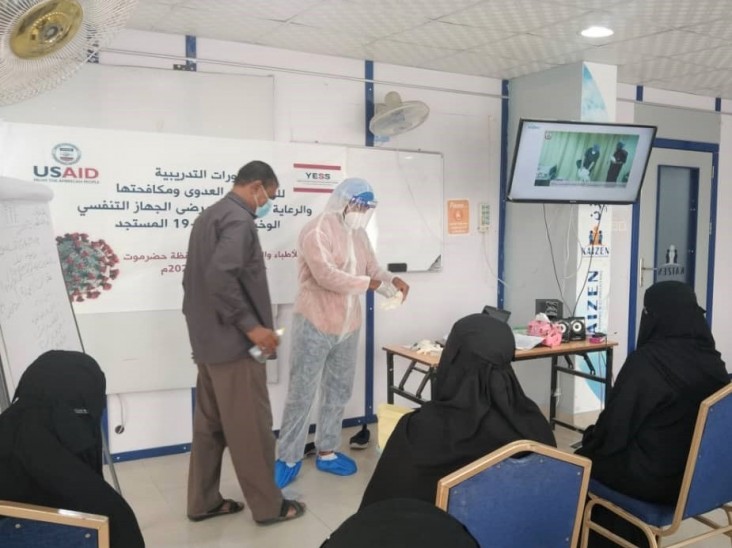Speeches Shim

Training Program Equips Doctors and Nurses with Critical Skills, Fills Staffing Gaps
“Before the training, healthcare workers did not implement basic protocols for COVID- 19. Now, many wrong behaviors and misconceptions have changed at the level of the medical staff in general, and at the individual level in particular.” -- Dr. Sarah Alajali, Ibn Sena Hospital, Mukalla, Hadramout
Yemen is facing the COVID-19 pandemic with a healthcare system that has been hollowed out by years of conflict, greatly reducing its ranks of medical practitioners. With just 10 healthcare workers per 10,000 people, Yemen is well below the international standard of 41 per 10,000. For job-seeking Yemenis, however, the unmet demand for health professionals offers a promising employment opportunity—especially for women—if they can access the training they need to succeed.
To help address the country’s shortage of medical staff, USAID’s Economic Recovery and Livelihoods Program (ERLP) has designed pre-employment training and up-skilling programs for current and prospective healthcare providers. The program will train and place 150 private sector and 650 public sector healthcare staff to fill critical skills gaps and hospital recruitment needs for qualified healthcare workers.
USAID also has supported multi-day training sessions for health practitioners on COVID-19 preparedness and response. So far, 611 doctors and nurses, including 299 women, have participated in sessions in Aden and Hadramawt focused on preventative measures to stem the virus’ spread and encourage the adoption of appropriate protocols for boosting COVID response capacity. The sessions have been well received by healthcare professionals, who had previously felt ill prepared to respond effectively to the risks and responsibilities of dealing with the coronavirus threat.
“The USAID training allowed for us as health workers to improve our skills and knowledge of key areas that are indispensable to avoid contracting COVID and to work comfortably without fear of the disease itself,” explains Dr. Sarah Al-Ajali, who tends patients at the Ibn Sena Hospital in Mukalla, Hadramawt Governorate. “The theoretical and practical training focused on COVID prevention and control, how to treat and isolate cases, and the protocols to follow according to the type and severity of the case.”
USAID adopts a demand-driven approach to its workforce development activities, a best practice that effectively bridges the gap between the large numbers of people looking for work and the need for skilled labor among employers. USAID directly solicits input from employers in high-growth sectors, such as health care services, to identify the types of skills they require. This feedback is then integrated into targeted workforce development interventions that prepare job seekers for the employment market and the chance at solid, sustainable careers.
In Hadramawt, Taiz, and Aden governorates, USAID has recruited healthcare coordinators to survey dozens of private medical centers and collect information on the skills gaps they are facing. More than 90 percent of the health centers surveyed report that they face acute shortages of qualified nurses, and are having to rely on under-trained staff who are able to provide only the most basic services. Indeed, nursing is a recognized growth area for workforce development, especially for Yemeni women, whose employment options are more limited compared to men. The shortage of nurses is aggravated by a dearth of training institutions to prepare certified professionals. Moreover, the programs that do exist fail to offer the kind of practical and task-oriented instruction required in real-life healthcare settings.
In response to the survey feedback, USAID created a training program for nursing that includes modules on both basic and advanced care techniques, along with the soft skills required to improve the quality of health service delivery. In addition, the trainees will take part in COVID preparedness workshops, and will complete a 30-day intensive practical training module. By the end of the program, the trainees will be ready to fill critical positions in public and private healthcare centers.
USAID is dedicated to delivering best-practice solutions that create employment and better livelihoods for the people of Yemen. By engaging with public and private healthcare providers, using a proven workforce development approach, USAID is helping to rebuild a sector in urgent need of advancement.
“The training program provided by USAID to the healthcare staff is considered a milestone in supplying the health sector with a number of well-trained and qualified workers able to use the latest medical equipment and healthcare best practices,” concludes Hisham Mol Aldawila, a nurse at Ibn Sena Hospital in Mukalla, who has experienced the benefits of the training first hand.
USAID’s Economic Recovery and Livelihoods Program (ERLP), addresses critical economic stabilization challenges in Yemen. At the macroeconomic level, it restores economic stability, enhances fiscal management, and increases international trade flows. At the microeconomic level, ERLP helps small producers create their own businesses, strengthens private sector performance and competitiveness, and creates jobs and new market linkages for sustainable livelihoods.

Comment
Make a general inquiry or suggest an improvement.